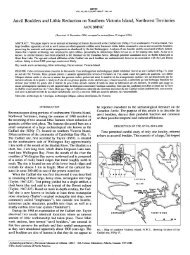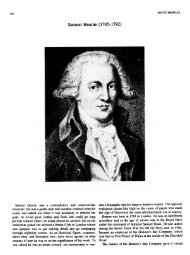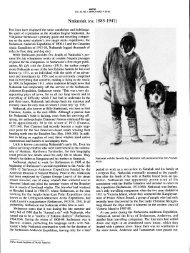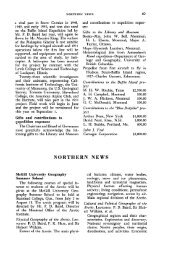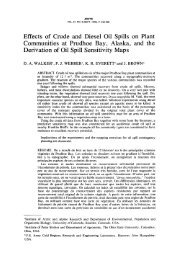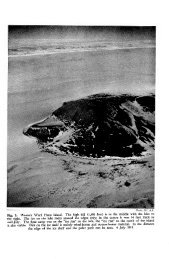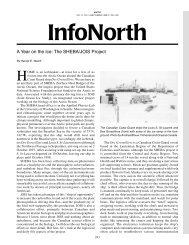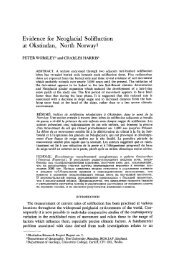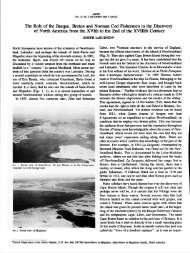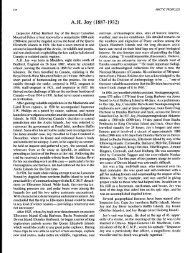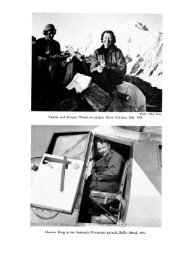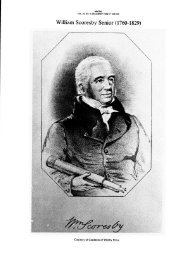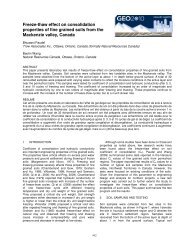NOTES ON THE NUNAMIUT ESKIMO AND MAMMALS OF ... - arctic
NOTES ON THE NUNAMIUT ESKIMO AND MAMMALS OF ... - arctic
NOTES ON THE NUNAMIUT ESKIMO AND MAMMALS OF ... - arctic
You also want an ePaper? Increase the reach of your titles
YUMPU automatically turns print PDFs into web optimized ePapers that Google loves.
174 <strong>THE</strong> <strong>NUNAMIUT</strong> <strong>ESKIMO</strong> <strong>AND</strong> <strong>MAMMALS</strong> <strong>OF</strong> <strong>THE</strong> ANAKTUVUK PASS REGI<strong>ON</strong><br />
came into the Eskimo camps, where they were killed. An aged man, the<br />
father of Kakinya, was attacked by a rabid wolf and bitten on the hand. He<br />
succeeded in killing the animal, and suffered no ill effects from the<br />
attacked by wolves in camp at night became rabid. A rabid wolf was seen<br />
bite. Dogs<br />
pursuing another apparently normal wolf which, in its desire to escape, ran<br />
close to a hunter and was killed. The rabid wolf, showing no fear of man,<br />
came near and was also shot. This outbreak followed a year of high wolf<br />
density, according to the trapping success of the Nunamiut. The resulting<br />
decrease in numbers, however, was apparently not great. There are no reports<br />
of attacks on man by normal wolves.<br />
Sex Weinht Sex Weight<br />
d<br />
d<br />
d<br />
3<br />
p”<br />
0<br />
55<br />
75<br />
78<br />
80<br />
106<br />
59<br />
63<br />
9<br />
0<br />
9<br />
0<br />
9<br />
0<br />
73<br />
80<br />
81<br />
85<br />
85<br />
87<br />
90<br />
Table 11. Weights of 14 wolves from the northern Brooks Range (in pounds).<br />
The Nunamiut stated that wolves were rare in the Anaktuvuk Pass region<br />
from about 1911 to 1920. During this time caribou were also scarce, perhaps<br />
as a result of their following migration routes which did not take them through<br />
this country. For the last few years wolves have been numerous; usually from<br />
20 to 30 are trapped each winter, but more than 150 were killed in the winter<br />
of 1942-3. Forty-eight wolves were killed during the winter of 1949-50.<br />
They are occasiobally shot during the summer and<br />
to trap them in these seasons.<br />
fall, but no effort is made<br />
I have never seen a place with as many wolves as the Savioyok valley<br />
during the early winter of 1950-1. The Eskimo who went into this valley<br />
shortly before I did reported that they were unable to sleep the first night<br />
because of the noise made by the wolves howling, and their own dogs replying.<br />
It is interesting that the greatest density of mountain sheep and moose that I<br />
have seen in the Brooks Range was found in this valley, despite the relatively<br />
large wolf population.<br />
A series of I5 wolf skulls has been deposited in the US. National Museum.<br />
A larger series of skulls, as yet unprepared, is in cold storage.<br />
Martes americana ?actuosa (Osgood). Ih~iatchid (“new wolverine”).<br />
Alaska marten.<br />
The marten is rare in the Anaktuvuk Pass region, and only one specimen,<br />
from Hunt Fork, was obtained. This animal was trapped by an Eskimo<br />
during the winter of 1948. According to Frank Bishop, marten do not occur<br />
far up the John River valley. It is possible that they are more abundant on<br />
the North Fork drainage where only a limited amount of field work was done.<br />
Marten tracks were observed in the Savioyok valley in the winter of 1949-50.<br />
The single marten obtained differs considerably from any specimen in the<br />
mammal collections at the US. National Museum. The ochraceous colouring



